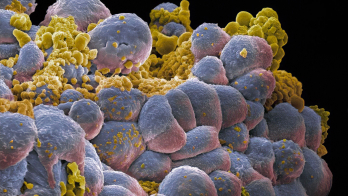Neutrons are a common by-product of particle-accelerator operations. While these particles can be studied or gainfully used, at other times they are a nuisance, with the potential to damage sensitive electronics and cause data-acquisition systems to fail mid-experiment.
Preventing neutrons from causing damage was a chief goal in the design of a shield house for an apparatus being built for the 12 GeV Upgrade project being carried out at the US Department of Energy’s Jefferson Lab. The $338 million upgrade will double the energy of the electron beam, adding an additional experimental hall while improving the existing halls along with other upgrades and additions.
The new apparatus, the Super High Momentum Spectrometer (SHMS), will enable measurements at high luminosity of particles with momentum approaching the beam energy, scattered at forward angles. It complements the existing High Momentum Spectrometer (HMS).
The physicists and engineers designing the SHMS shield house capitalized on data from more than 15 years of operations with the HMS and various large, open detector systems operated at Jefferson Lab. Using Monte Carlo calculations carried out with Geant4, material specifications were optimized for shielding the electronics from neutrons. However, current technologies did not meet the requirements. Existing systems were too bulky, expensive and difficult to manufacture. So a new system was designed, consisting of three parts: a hydrogen-rich and lightweight concrete layer to thermalize neutrons, a boron-rich concrete layer to absorb them and a thin lead layer to halt residual radiation.
The hydrogen-rich, lightweight concrete is the main structural component of the shield house. This material lacks most of the grit and rocks in ordinary concrete and instead contains shredded plastic and lightweight shale. It looks and pours like concrete and has the same strength, but it has two-thirds of the weight and has four times the neutron-thermalizing capability.
The boron-rich concrete is similarly produced using a patented new recipe, with boron powder replacing the typical aggregate. The boron-rich concrete has the same consistency and strength as ordinary concrete and concrete simply doped with boron, yet stops neutrons with less material. A protective layer that is 15 cm thick encloses concrete electronics rooms in the SHMS shield house, topped with thin lead plates to stop the 0.48 MeV γ rays produced in neutron–boron interactions. A third, panel-like product was designed to stop neutrons in space-constricted areas. It is about 2.5 cm thick and consists of boron embedded in an epoxy resin.
All of the new products are easily manufactured using existing techniques, and systems built with these patented and patent-pending technologies have applications in nuclear-waste storage, compact nuclear reactors and for shielding radiation sources in medical applications.







